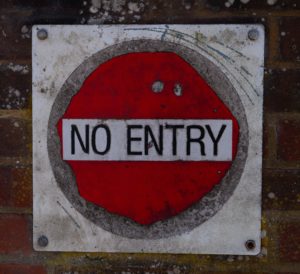
Sign that says “no entry”
Accessibility. How accessible is it? Questions and thoughts bubbled up while listening to Kim Ashbourne, one of the presenters this week. Kim talked to us about web accessibility and it was very informative, covering some accessibility considerations that I had not thought of before. Sure, I ensure that students have voice to text options, audio books for novel studies, that I provide clear instructions, both orally and in written format and… I may once in a while act things out in an attempt to get my point across/or drone on with, “anyone, anyone” ( a reference to Ferris Bueller’s Day Off that maybe one student in the class understands) in order to gain everyone’s attention. In addition to this, the Learning Management System (LMS) we use (Moodle) has some accessibility features built right into it (colors/font sizes, text-to speech, transcriptions of video ( although not all have this feature) to name a few. However, I do not often think about accessibility or about how accessible any content I create online is. The awesome thing about this presentation was that it now has me thinking about accessibility both within my teaching face-to face, online as well as within the Learning Management System (LMS) I use in my teaching.
As an English teacher, the points Kim made connected to the clarity of the written word also resonated with me. When students are not face to face with you, this clarity becomes even more important as we are unable to see the looks of confusion, disengagement or the path they have taken. The other piece I took away from this is that these are skills that students also need to be taught. Sure, I teach them how to create organized essays, how to include headings and images, but many of these accessibility considerations I have not specifically taught them. It would be interesting to have students look at some sites online to determine the accessibility of them and to consider how the layout of the site impacts them, and how it might impact someone with a physical or cognitive disability. I would also like them to consider how some individuals may lack access to certain cites or many lack access to any technology/have limited technology.
While doing some research this week, I stumbled upon a quote from Writing on Social Media: a Review of Research in the High School Classroom . This quote really resonated with me as I have begun working on and considering content in advance of co-designing a Moodle course for the fall and, more recently have been searching for resources connected to assessment.
“These assessments should consider students’ writing in light of traditional academic literacies (e.g., clarity, coherence, use of writing conventions), as well as in light of non-traditional or new literacies (e.g., use of images, hyperlinks, multimedia) and consider whether and how the writing effectively communicates in the social context (67).”
This quote also connects to concepts shared within the accessibility presentation as understanding and teaching students how to use these new literacies will also allow for further instruction and learning connected to accessibility.
Check out Ashbourne’s blog page for more information connected to accessibility including: creating accessible word files, making your website accessible, text to speech resources and how to make your LMS courses accessible.
Also, check out this blog page on How to Create Accessible Content.
Photo by Matt Seymour on Unsplash
References
Galvin, S., & Greenhow, C. (2020) Writing on Social Media: a Review of Research in the High School Classroom. TechTrends 64, 57–69. https://doi.org/10.1007/s11528-019-00428-9